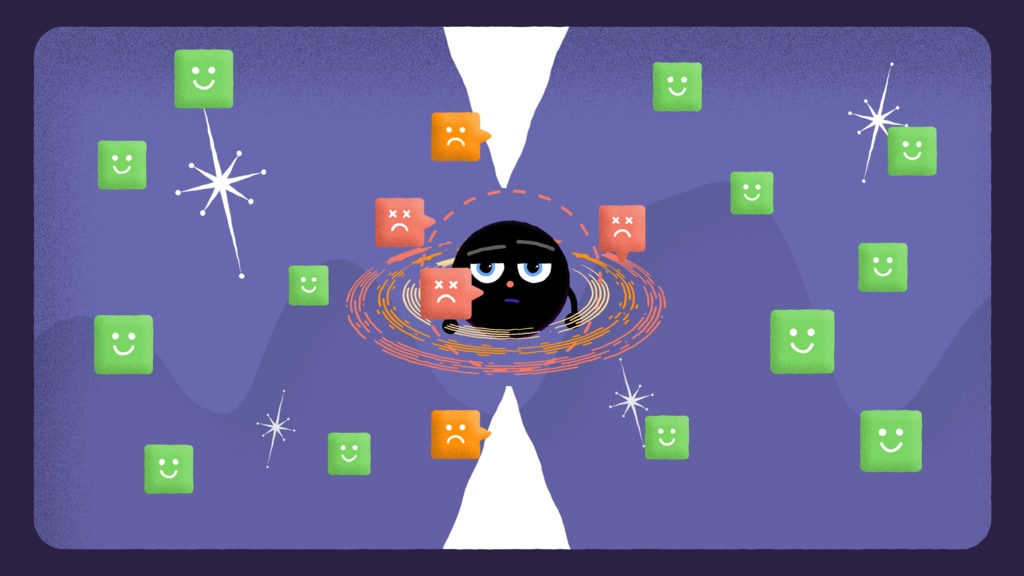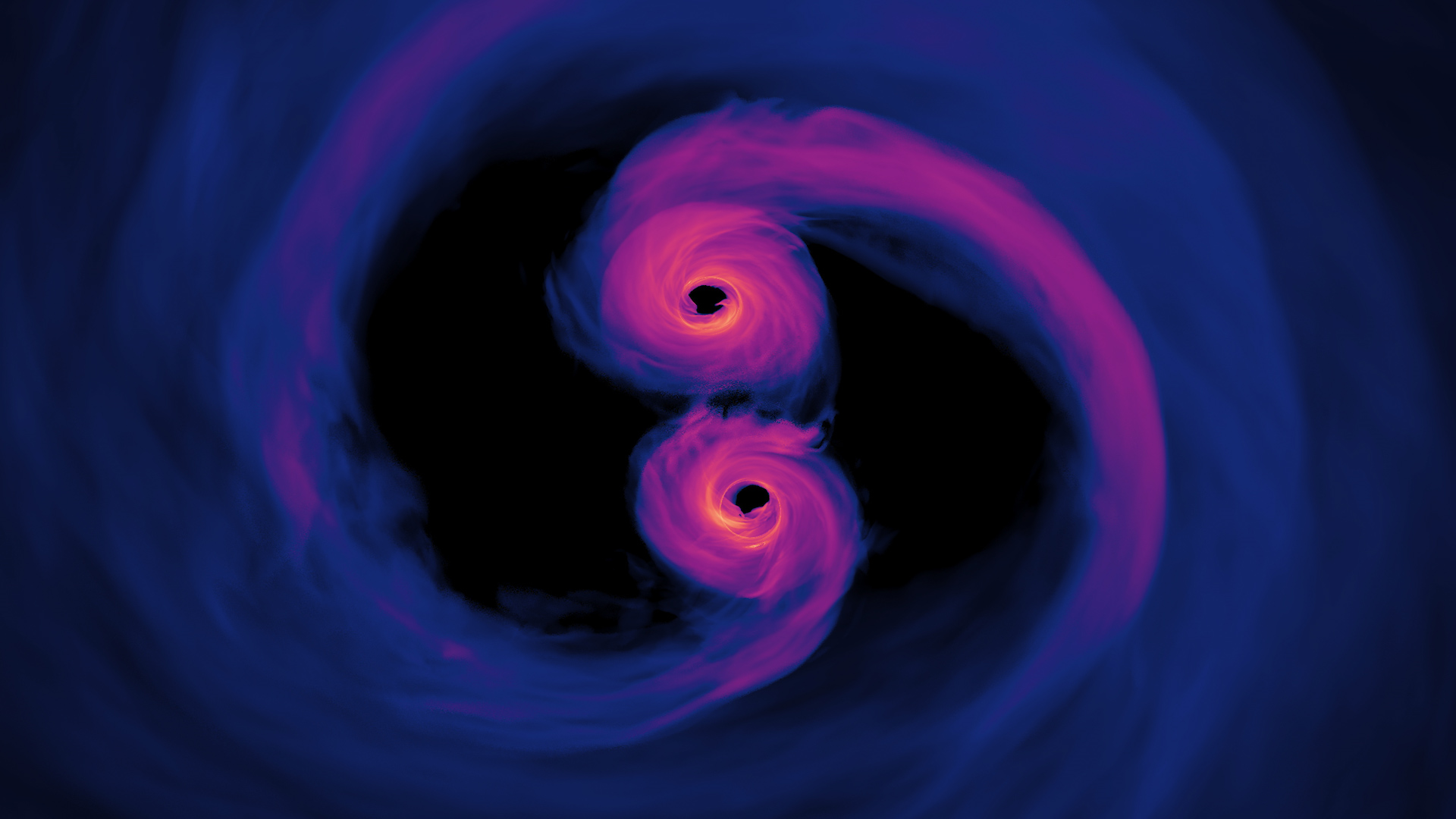Astrophysics Valentines
Download our astrophysics-themed valentines!

Will you still love me tomorrow?
Many cosmic couples, from binary stars to gravitationally bound galaxies, spend millions or even billions of years together — but some age more gracefully than others.
Credit: NASA's Goddard Space Flight Center

You make my heart flutter!
The heart of this supernova remnant accelerates protons to nearly the speed of light.
Image credit: Jayanne English (University of Manitoba), Canadian Galactic Plane Survey/DRAO, and NASA/Fermi/Fang et al. 2022

You make my heart go boom.
An illustration of a supernova explosion caused by the collapse of a massive star. At the center is an animated pulsation heart with the text “You make my heart go boom!” around the heart.
Image credit: NASA’s Goddard Space Flight Center/Chris Smith (KBRwyle)

I get a kick out of you.
Observations using the Very Large Array radio telescope (orange) reveal the needle-like trail of pulsar J0002+6216 outside the shell of supernova remnant CTB 1. The pulsar escaped the remnant some 5,000 years ago. Overlay text says: “I get a kick out of you.”
Image credit: Credit: Composite by Jayanne English, University of Manitoba, using data from NRAO/F. Schinzel et al., DRAO/Canadian Galactic Plane Survey and NASA/IRAS

I'm tangled up with you.
A yarn illustration of a black hole pulling in an unfortunate star and getting pulled apart and unraveled by it. This type of cosmic occurrence is called a tidal disruption event. The material from the star will now orbits the black hole for a long time before being pulled into it. Overlay text says: “I’m tangled up with you!”
Image credit: NASA’s Goddard Space Flight Center/Chris Smith (KBRwyle)

You are my heart & soul.
The Heart (upper right) and Soul (lower left) nebula seen in an infrared mosaic from NASA's Wide-field Infrared Survey Explorer, or WISE, zooming in and out similar to a heartbeat with the text: “You are my heart and soul”.
Image credit: NASA/JPL-Caltech/UCLA

You blow me away!
Eta Carinae is famous for a brilliant and unusual outburst, called the "Great Eruption.” It's located about 7,500 light-years from Earth and contains one of the biggest and brightest stars in our galaxy. Learn more here.
Image credit: Credit: A. Fujii, J. Morse (BoldlyGo Inst), N. Smith (U Arizona), Hubble SM4 ERO Team, NASA, ESA, STScI, JPL-Caltech, CXC, ESO, NOAO, AURA, NSF

Love is in the air and so is the flying telescope SOFIA, the Stratospheric Observatory for Infrared Astronomy. It carries a 2.7-meter telescope in a modified Boeing 747-SP aircraft to study the universe with infrared light that does not reach Earth’s surface.
Credit: NASA/SOFIA/Proudfit

Each of the James Webb Space Telescope's 18 beryllium mirrors is coated with a thin layer of gold to better reflect infrared light.

With its longer wavelength coverage and much greater sensitivity than Hubble, the James Webb Space Telescope will be able to study distant planets and the earliest stages of the universe.

The Nancy Grace Roman Space Telescope will have 18 detectors to Hubble's one, allowing it to see 100 times as much sky.

The Nancy Grace Roman Space Telescope's enormous field of view will allow it to see large pieces of the the sky.

The Nancy Grace Roman Space Telescope will increase our understanding of the nature of the universe.

Planets orbiting distant worlds are one of the targets for the Nancy Grace Roman Space Telescope.

This image of the “Tarantula Nebula” (officially known as 30 Doradus) combines data from the Chandra X-ray Observatory and James Webb Space Telescope.
Credit: X-ray: NASA/CXC/Penn State Univ./L. Townsley et al.; Infrared: NASA/ESA/CSA/STScI/JWST ERO Production Team

NASA’s Fermi Gamma-ray Space Telescope is a powerful space observatory that opens a wide window on the universe. Fermi scans the entire sky every three hours as it orbits Earth, setting its sights on supermassive black holes, gamma-ray bursts, pulsars, and more.
Credit: NASA’s Goddard Space Flight Center/Chris Smith (USRA/GESTAR)

NASA’s Fermi Gamma-ray Space Telescope is a powerful space observatory that opens a wide window on the universe. Fermi scans the entire sky every three hours as it orbits Earth, setting its sights on supermassive black holes, gamma-ray bursts, pulsars, and more.
Credit: NASA’s Goddard Space Flight Center/Chris Smith (USRA/GESTAR)

These two black holes are just 40 orbits away from merging in this simulation of the light their environment emits as they dance. Vertical version.
Credit: NASA’s Goddard Space Flight Center

These two black holes are just 40 orbits away from merging in this simulation of the light their environment emits as they dance.
Credit: NASA’s Goddard Space Flight Center

A love like ours is so rare...
It's more than normal space and time can bear.

Traveller valentine's day

Valentine,
My pulse races when I'm around you!
Want more? Check out these two pages:
NASA Valentines
Send-A-Card

Valentine,
You're the brightest object in my sky!

Roses are red,
violets are blue.
My day could be nice,
but it'd be NICER with you!
Credits
Please give credit for this item to:
NASA's Goddard Space Flight Center. However, individual items should be credited as indicated above.
-
Artists
- Chris Smith (USRA)
- Jeanette Kazmierczak (University of Maryland College Park)
- Isabelle Yan (NASA/GSFC)
- Kelly Ramos (Business Integra)
- Sara Mitchell (University of Maryland College Park)
- Barb Mattson (University of Maryland College Park)
Release date
This page was originally published on Friday, February 14, 2020.
This page was last updated on Tuesday, February 13, 2024 at 8:41 AM EST.

